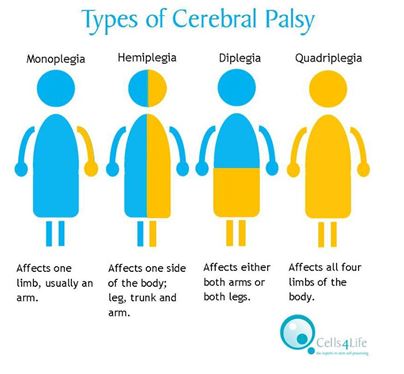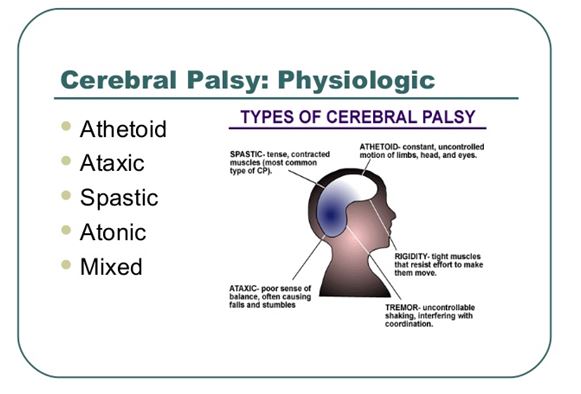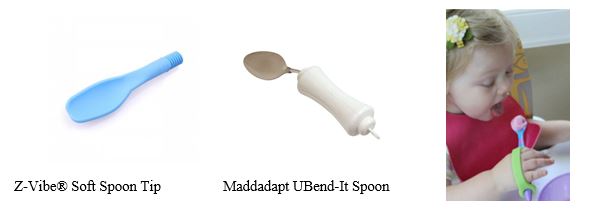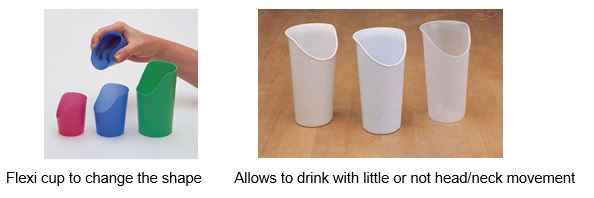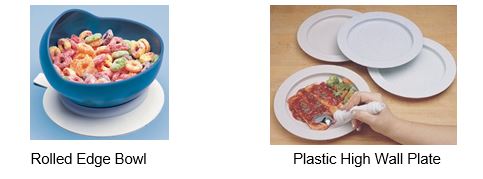Managing Feeding in Children with Cerebral Palsy: Difference between revisions
(Introduction images) |
(Dysphagia) |
||
| Line 20: | Line 20: | ||
2. According to topographical distribution. Diplegia, hemiplegia, quadriplegia | 2. According to topographical distribution. Diplegia, hemiplegia, quadriplegia | ||
[[Image: | [[Image:Classification CP.JPG|center]]<br> | ||
3. According to predominant motor characteristic (physiological grouping): spastic, dyskinetic, ataxic | 3. According to predominant motor characteristic (physiological grouping): spastic, dyskinetic, ataxic | ||
[[Image: | [[Image:Classification CP2.JPG|center]]<br> | ||
4. Functional: According to the Gross Motor Classification System, the Manual Ability Classification System (MACS), the Functional Mobility Scale (FMS).<br> | 4. Functional: According to the Gross Motor Classification System, the Manual Ability Classification System (MACS), the Functional Mobility Scale (FMS).<br> | ||
What other characteristics a child with cerebral palsy might have?<br>• Multiple disabilities<br>• Cognitive: Intellectual disabilities<br>• Sensory: abnormal touch or pain perceptions. Difficulty with vision and hearing. <br>• Difficulty with sucking or eating<br>• Motor impairments (stiffness, weakness, writhing movements)<br>• Epilepsy | What other characteristics a child with cerebral palsy might have?<br>• Multiple disabilities<br>• Cognitive: Intellectual disabilities<br>• Sensory: abnormal touch or pain perceptions. Difficulty with vision and hearing. <br>• Difficulty with sucking or eating<br>• Motor impairments (stiffness, weakness, writhing movements)<br>• Epilepsy | ||
<br><br> | == <br>Dysphagia in Cerebral Palsy<br> == | ||
=== Swallowing<br> === | |||
Swallowing is a complex neuromuscular process, whereby food from the mouth passes through the pharynx and esophagus into the stomach.<br>It corresponds to swallowing food and saliva, and in general, in making move from the mouth to the stomach any liquid food (water, juice, milk, etc.), semi-solid (porridge, compote, among others) and solids (biscuits, bread, meat and others)<br> | |||
=== <br>Dysphagia<br> === | |||
Dysphagia is difficulty swallowing and is evaluated by a professional speech pathologist and multidisciplinary team. This evaluation is performed through clinical observation, in addition, objective (or laboratory) evaluation methods can be used, such as videofluoroscopy and fiberoptic endoscopy swallowing (FEES).<br> | |||
=== <br>Neurogenic Dysphagia<br> === | |||
Neurogenic Dysphagia is an alteration of swallowing as a consequence of an alteration of the central or peripheral nervous system, which causes difficulty in any of the stages of swallowing. As a consequence of these alterations we may find dehydration, malnutrition, obstruction of the airway and pneumonia.<br><br> | |||
=== Signs and symptoms are associated with Dysphagia<br> === | |||
*'''Sialorrhea''': Sialorrhea is the unintentional loss of saliva from the mouth. This can be due to excessive production of saliva, lack of control of the lips and lack of lip closure (inadequate oral motor control).<br> | |||
*'''Delayed laryngeal elevation reflex''': The reflex laryngeal elevation (10-15 mm) supports the closure of the airway and the passage of food into the esophagus. A normal delay is between 0.8 and 1 second. The laryngeal reflex is considered to be delayed when it takes more than 2 seconds to appear.<br> | |||
*'''Penetration and aspiration of food''': The penetration of food occurs when it is above the level of the vocal cords, without getting to enter the lungs. In the aspiration the food enters the lungs (which can provoke pneumonias or other respiratory symptoms), being able to catch reflex of cough or to be a silent aspiration (without reflex of cough).<br>The cough allows expulsion of foreign bodies entering the airway, this is a measure of natural protection (physiological) that the human body has, in some children or young people with cerebral palsy this reflex is absent or greatly diminished. Food penetration or aspiration can occur at three crucial points in the swallowing process: Before swallowing, during swallowing or after swallowing of food.<br> | |||
*'''Chewing with open mouth''': Insufficient control of the mandible favors the appearance of incorrect chewing movements (patterns). Proper mastication involves vertical, lateral and rotational movements, with adequate closure of the lips or mouth, which prevents food from escaping from the mouth. Children with hypertonia or hypotonia present difficulties in the correct sealing of the lips when chewing.<br> | |||
*'''Voice changes (wet voice)''': When food penetration or aspiration occurs, the mucous membrane covering the vocal cords is modified; this change produces a change in the voice and is what we call speech therapists a "wet voice". In those children, youngsters or young people who can not speak, this humid voice is evident in the cry or cry.<br> | |||
*'''Persistence of oral primitive reflexes and pathological reflexes''': Primitive reflexes are all those that are present from birth to the age of abolition and are part of the normal development of the human being. These reflexes are: suction reflex, search reflex, bite reflex and arcade reflex.<br>The pathological reflexes are all those that are present in front of an alteration of the nervous system and are not part of the normal psychomotor development of the child. These reflexes are: lingual protrusion reflex, dystonia reflexes of the mouth or dystonia with open mouth and tonic bite reflex.<br><br> | |||
== Delivering food<br> == | |||
For the correct delivery of the food you must use a suitable food utensil. These can be spoons (metal or plastic) vases, plates, forks, etc. All these utensils can be those of daily use or with adaptations. From time to time they should be checked for condition and replacement due to wear. Whenever they are used they should be disinfected safely, either by washing them with soap and water or disinfectants.<br> | |||
<br> | <br> | ||
=== Eating utensils<br> === | |||
*'''Breastfeed''':The use of a bottle should be for those children who have a safe swallowing of liquids. Good posture and correct management technique should be maintained.The child should be as well seated as possible and have a head support to avoid hyperextension. | |||
*'''Spoon''': This is the main food utensil; it an be metal or plastic. We must have some considerations for its use. The spoon should never be larger than the tongue of the child, girl or young person. If there is a tonic bite, use a plastic spoon that is resistant.<br> | |||
[[Image:Spoon2CP.JPG|center]]<br> | |||
*'''Nosey cup''': This vessel has a recess in an edge that facilitates the ingestion of liquids (in those children or young people who can ingest them) because the liquid can be ingested without making head hyperextension.<br> | |||
[[Image:Nosey_cup_CP.JPG|center]]<br> | |||
*'''Plate with flange''':The main characteristic of this dish is that it has a raised edge, which facilitates the withdrawal of food from the dish, mainly used in children and young people who can feed themselves and use cutlery (normal or adapted). | |||
[[Image:Plate_CP.JPG|center]]<br> | |||
==== How to deliver food to the child<br> ==== | |||
The delivery of the food considers several aspects. At the stage of preparation for food, we must consider three key elements:<br> | |||
#First, consider the type of food (liquid, porridge, whole) that the child ingests and the feeding way (mouth, nasogastric probe or mixed route). | |||
#Second, the food utensil to be used, usually a small metallic spoon (tea), which is not larger than the child's or young person's tongue. If there is a strong bite, use a plastic spoon that is strong. An adapted spoon can also be used in children or young people who have the physical skills to use it. | |||
#Third, we must consider the posture before and during the feeding process | |||
During the feeding process, we must consider the way of approaching the spoonful of food, which must always enter from the bottom up and front, placing the well with the food in front of the child. This favors anticipation of the food process. A common precaution is to fill the spoon with food only halfway. | |||
==== The child that can’t close the mouth while eating ==== | |||
One of the most common problems is that the child can not close their mouth (lip closure), which is related to oral motor control. To promote the correct closure of the lips and mouth, two techniques can be used:<br>1. The first is the frontal oral motor control. To do this, place the thumb on the chin under the lower lip, the index finger on the cheek and the other three fingers on the floor or base of the mouth.<br><br><br> | |||
<br> | <br> | ||
<br> | <br> | ||
Revision as of 14:37, 31 May 2017
Introduction
[edit | edit source]
Eating
[edit | edit source]
Eating is one of the fundamental processes in life. We can define it as a process for which all living entities consume different types of food with the objective of receiving necessary nutrients to survive.
But eating is much more than just consuming food. It is a moment of communication, of transmission of traditions, culture and transfer of affection. Sharing food with others is a human activity with important significance, one of them is the integration of the family and to a social group.
When this is not possible or it is difficult because a member of the group has specific problems with eating, the process of inclusion of the child to the family and community might not go smoothly. This is why that one of the main objectives for parents is to find a positive and easy way to feed their child.
Cerebral Palsy
[edit | edit source]
Cerebral palsy is an umbrella term that refers to a group of disorders affecting a person’s ability to move. It is due to damage to the developing brain either during pregnancy or shortly after birth.
Cerebral palsy affects people in different ways and can affect body movement, muscle control, muscle coordination, muscle tone, reflex, posture and balance. Although cerebral palsy is a permanent life-long condition, some of these signs of cerebral palsy can improve or worsen over time.
People who have cerebral palsy may also have associated problems such as respiratory difficulties, Dysphagia, cognitive difficulties etc.
How can we classify Cerebral Palsy?
[edit | edit source]
1. According to muscle tone (state of permanent contraction of the muscle).
- Hypertonia (rigid limbs)
- Hypotonia (limbs and trunk with low muscle tone, often involving reduced muscle streng.
2. According to topographical distribution. Diplegia, hemiplegia, quadriplegia
3. According to predominant motor characteristic (physiological grouping): spastic, dyskinetic, ataxic
4. Functional: According to the Gross Motor Classification System, the Manual Ability Classification System (MACS), the Functional Mobility Scale (FMS).
What other characteristics a child with cerebral palsy might have?
• Multiple disabilities
• Cognitive: Intellectual disabilities
• Sensory: abnormal touch or pain perceptions. Difficulty with vision and hearing.
• Difficulty with sucking or eating
• Motor impairments (stiffness, weakness, writhing movements)
• Epilepsy
Dysphagia in Cerebral Palsy
[edit | edit source]
Swallowing
[edit | edit source]
Swallowing is a complex neuromuscular process, whereby food from the mouth passes through the pharynx and esophagus into the stomach.
It corresponds to swallowing food and saliva, and in general, in making move from the mouth to the stomach any liquid food (water, juice, milk, etc.), semi-solid (porridge, compote, among others) and solids (biscuits, bread, meat and others)
Dysphagia
[edit | edit source]
Dysphagia is difficulty swallowing and is evaluated by a professional speech pathologist and multidisciplinary team. This evaluation is performed through clinical observation, in addition, objective (or laboratory) evaluation methods can be used, such as videofluoroscopy and fiberoptic endoscopy swallowing (FEES).
Neurogenic Dysphagia
[edit | edit source]
Neurogenic Dysphagia is an alteration of swallowing as a consequence of an alteration of the central or peripheral nervous system, which causes difficulty in any of the stages of swallowing. As a consequence of these alterations we may find dehydration, malnutrition, obstruction of the airway and pneumonia.
Signs and symptoms are associated with Dysphagia
[edit | edit source]
- Sialorrhea: Sialorrhea is the unintentional loss of saliva from the mouth. This can be due to excessive production of saliva, lack of control of the lips and lack of lip closure (inadequate oral motor control).
- Delayed laryngeal elevation reflex: The reflex laryngeal elevation (10-15 mm) supports the closure of the airway and the passage of food into the esophagus. A normal delay is between 0.8 and 1 second. The laryngeal reflex is considered to be delayed when it takes more than 2 seconds to appear.
- Penetration and aspiration of food: The penetration of food occurs when it is above the level of the vocal cords, without getting to enter the lungs. In the aspiration the food enters the lungs (which can provoke pneumonias or other respiratory symptoms), being able to catch reflex of cough or to be a silent aspiration (without reflex of cough).
The cough allows expulsion of foreign bodies entering the airway, this is a measure of natural protection (physiological) that the human body has, in some children or young people with cerebral palsy this reflex is absent or greatly diminished. Food penetration or aspiration can occur at three crucial points in the swallowing process: Before swallowing, during swallowing or after swallowing of food.
- Chewing with open mouth: Insufficient control of the mandible favors the appearance of incorrect chewing movements (patterns). Proper mastication involves vertical, lateral and rotational movements, with adequate closure of the lips or mouth, which prevents food from escaping from the mouth. Children with hypertonia or hypotonia present difficulties in the correct sealing of the lips when chewing.
- Voice changes (wet voice): When food penetration or aspiration occurs, the mucous membrane covering the vocal cords is modified; this change produces a change in the voice and is what we call speech therapists a "wet voice". In those children, youngsters or young people who can not speak, this humid voice is evident in the cry or cry.
- Persistence of oral primitive reflexes and pathological reflexes: Primitive reflexes are all those that are present from birth to the age of abolition and are part of the normal development of the human being. These reflexes are: suction reflex, search reflex, bite reflex and arcade reflex.
The pathological reflexes are all those that are present in front of an alteration of the nervous system and are not part of the normal psychomotor development of the child. These reflexes are: lingual protrusion reflex, dystonia reflexes of the mouth or dystonia with open mouth and tonic bite reflex.
Delivering food
[edit | edit source]
For the correct delivery of the food you must use a suitable food utensil. These can be spoons (metal or plastic) vases, plates, forks, etc. All these utensils can be those of daily use or with adaptations. From time to time they should be checked for condition and replacement due to wear. Whenever they are used they should be disinfected safely, either by washing them with soap and water or disinfectants.
Eating utensils
[edit | edit source]
- Breastfeed:The use of a bottle should be for those children who have a safe swallowing of liquids. Good posture and correct management technique should be maintained.The child should be as well seated as possible and have a head support to avoid hyperextension.
- Spoon: This is the main food utensil; it an be metal or plastic. We must have some considerations for its use. The spoon should never be larger than the tongue of the child, girl or young person. If there is a tonic bite, use a plastic spoon that is resistant.
- Nosey cup: This vessel has a recess in an edge that facilitates the ingestion of liquids (in those children or young people who can ingest them) because the liquid can be ingested without making head hyperextension.
- Plate with flange:The main characteristic of this dish is that it has a raised edge, which facilitates the withdrawal of food from the dish, mainly used in children and young people who can feed themselves and use cutlery (normal or adapted).
How to deliver food to the child
[edit | edit source]
The delivery of the food considers several aspects. At the stage of preparation for food, we must consider three key elements:
- First, consider the type of food (liquid, porridge, whole) that the child ingests and the feeding way (mouth, nasogastric probe or mixed route).
- Second, the food utensil to be used, usually a small metallic spoon (tea), which is not larger than the child's or young person's tongue. If there is a strong bite, use a plastic spoon that is strong. An adapted spoon can also be used in children or young people who have the physical skills to use it.
- Third, we must consider the posture before and during the feeding process
During the feeding process, we must consider the way of approaching the spoonful of food, which must always enter from the bottom up and front, placing the well with the food in front of the child. This favors anticipation of the food process. A common precaution is to fill the spoon with food only halfway.
The child that can’t close the mouth while eating[edit | edit source]
One of the most common problems is that the child can not close their mouth (lip closure), which is related to oral motor control. To promote the correct closure of the lips and mouth, two techniques can be used:
1. The first is the frontal oral motor control. To do this, place the thumb on the chin under the lower lip, the index finger on the cheek and the other three fingers on the floor or base of the mouth.
